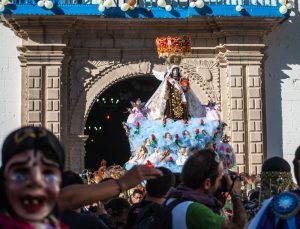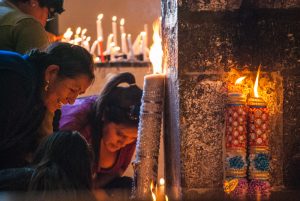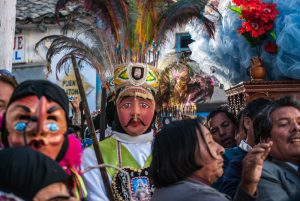
Fiestas abound in Peru. Part of the country’s pre-conquest heritage and the difficult history of struggles and innovations after the Spanish conquest, they are both a place where people experience religious passion and many, many more things, so many they are impossible to describe adequately.
Last week, the 15th of July, Peru celebrated the feast of the Virgin of Carmen (Mount Carmel as she is usually called in English). Everywhere she is important, whether to a group of urban faithful, a school, or to a neighborhood or town for whom she is their Holy Patronness.
One such place lies in a mountain valley some 100 kilometers from the city of Cuzco. Called Paucartambo, it is in between the highlands and the lowlands of Qosñipata, famous for coca leaves, citrus, and other tropical products. It is also between the capital and commercial center of Cuzco and Paucartambo’s agricultural hinterland at a wide range of altitudes from very high to very low.
For tourists is is most significant, outside of this feast, as a way station on the road to the Manu National Park, although most tourists simply fly over it.

Paucartambo has become an important place of pilgrimage, as people come from all over Peru and portions of the world for the feast of the Virgin of Carmen who is the town’s patron saint.

From the 15-18th of July, every year, the town fills to overflowing. People sleep in the streets or stay up all night roaming to stay awake and warm since there are no more rooms available, though they stay for the activities of the fiesta.
The festival itself is a whirl of activity that, while it fits some forms, is much more than those. It is an overwhelming twining of cacophony in music and dance.
From each sector of the town parade at different times and places brilliantly costumed troupes of dancers. The troupes are tightly organized by confraternities with a base in the town and represent figures from Paucartambo’s historical memory.
The confraternities are closed to outsiders, unless invited to join, and are composed of networks of kin and friends who may reside in the national capital of Lima, in another country, in the city of Cuzco, or in Paucartambo. But they have some connection to the town.

Because the dancers perform every year and practice in between times in a series of events held by the confraternity, they dance intensely and with great passion and precision.
Their dancing is not only about religious commitment but also about the importance of this connection with other members of the confraternities.
When in Paucartambo, their confraternity has a home, a site where they eat together and often also sleep (although that is frankly a rarity during the feast). Otherwise they are moving in concerted rhythm through the town’s streets, often in opposite directions from other dance troupes.
When the Virgin comes out of the Church, the organize themselves in relationship to her for the procession. Otherwise they are mostly on their own.
Within the feast several dramas are performed. In Colonial times the feasts were theatrical, involved with presenting passion plays of the life of Christ and the Saints, as well as historic events such as the conquest of Peru and the death of the Inca Atahuallpa.

The first drama is one where Qhapac Qollas dressed as herders and merchants from the high plateau of the south find themselves on a tower in the main square of Paucartambo. There, while the various troupes dance around the plaza in one direction or another, bands blaring and beer flowing (despite signs banning alcohol sales in the plaza), the Qollas begin to toss gifts of household goods and food from the tower to the delight of the crowd. People reach and jump into the air to catch a red plastic colander or a wooden foot stool.
After a while, an orange or two, officially a green or bad one, is thrown back at them as an expression of a battle that is trade. This tension is deeply Andean and speaks of relations among different sections of the town, but also different regions of Peru. Of course, according to David Graeber, tension, violence and even battle lie at the basis of economic trade among strangers in the history of human economics.
The second drama takes place when the Virgin processes in a parade with multiple dance troupes dancing backwards in front of her. Before the procession starts demons, called Saqra, a combination of ancient earth deities and Catholic ideas of the Devil, climb up on roof tops and balconies along her path. They reach out to her and try to pull her in, while the procession continues past. Unlike most Christian understandings of the tension between good and bad, the Virgin never defeats the Saqra nor they her. Instead the continue in eternal tension and difference.

The third drama takes place on the last day of the feast. It is a pitched battle between the highlands, in the persons of the Qhapaq Qollas, and the lowlands, in the figure of Qhapag Chunchus. The battle is a replaying of a historical battle between the Indians that live in the jungle below Paucartambo and the Highlanders above them. Fought in the town, the lowlanders won and they win every year in the replaying of the battle in the annual feast.
Finally, the last drama takes place constantly, whenever the ritual clowns, the Maqt’as with their whips (slings) run into the crowd. The Maqt’a discipline the crowd to make openings for the dancers to move through as if unaware of the people pressing on them. They keep photographers in line and out of the flow by snapping them on the back or on their legs with the taught whips.
The Maqt’as also make fun of people by flirting with men and women, feigning sex, carrying genitals of animals with which to threaten spectators, and so on. They are the life of the feast and are worth paying close attention to, even if the dancers seem to pull you in.
Puacartambo is a whirl of movement, color, sound, and activity along with moments of calm. The smallness of the town intensifies the feast. It is even more vivid and more vigorous than the massive feasts of Cuzco.






